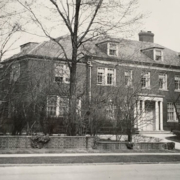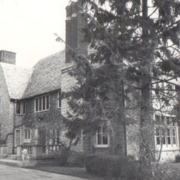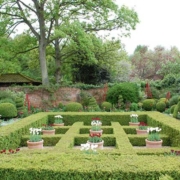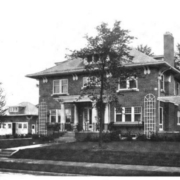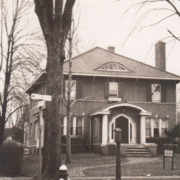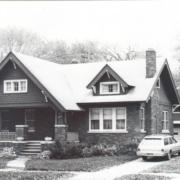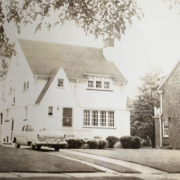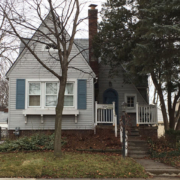Historical Architecture of Grosse Pointe – An Elegant Home – 30 Preston Place
Nestled in the corner of Grosse Pointe Farms is a small dead end street – Preston Place.
Preston Place was originally part of Kercheval, however over the years the land was sub-divided, with the separate plots of land creating the Preston Place subdivision.
The home was the recent location for the Grosse Pointe Historical Society’s Pop-Up tour, and we would like to thank the Historical Society for contributing a large amount of their research to us for this blog post.
So lets travel back in time to 1920 – Ms. Louise Webber, niece of J.L.Hudson (of Hudson’s Department store), is living with her husband Roscoe Jackson, president of the Hudson Motor Car Company, in an Arts and Crafts style home (designed by Leonard B. Willeke) in Indian Village.
Looking to reside next to the lake in Grosse Pointe Farms, we believe, based on research from the Historical Society, Louise Webber commissioned the home during the early 1920’s.
New York architect Duncan Candler was hired to design the house. Mr. Candler was a prominent architect in Maine. He designed many large prestigious residences, including a summer residence in Seal Harbor, Maine for the Rockefellers, along with creating Skylands, the Edsel Ford estate that is now owned by Martha Stewart. He is also credited with designing the Grace Dodge Hotel in Washington D.C, opening in 1921.
It is not known, however, when Chandler completed the design for the home and it was nearly ten years later before it was actually built. Prior to its completion Louise Webber lost her husband, Mr. Jackson, when he died unexpectedly while on a trip to Europe in 1929. They believe this tragic event, coupled with the dramatic downturn in the economy; courtesy of the Great Depression resulted in the delay to the home being built until 1932 when 486 Kercheval (now known as 30 Preston Place) was finally completed.
The Grosse Pointe Historical Society (GPHS) believes Ms. Webber used the residence primarily as a springtime home, spending the rest of the year in Palm Beach, Florida and Bay Harbor, Maine.
It is a lavish property, set on 10 acres of land, in a wooded area with a view of the lake.
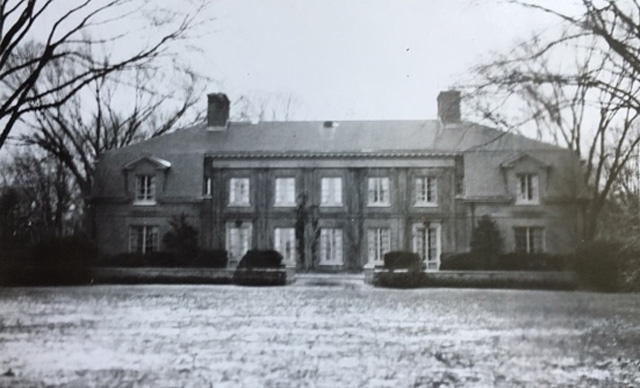
No expense was spared on the 9,000sq ft brick residence. The impressive formal entrance opens onto a stunning foyer with beautiful curved walls, and intricate detailing on the plaster. The library is sublime. The photos below depict the wonderful teakwood bas-reliefs. There are 12 in total, depicting wildflowers and birds – attributed to noted artist William Zorach.


Library

Teakwood bas-relief in the library.

Teakwood bas-relief in the library.

Teakwood bas-relief in the library.
Many of the rooms feature large fireplaces and an abundance of decorative detail, including the wood paneled ‘Gentleman’s Room’. There are 7 bedrooms in total, including 4 full baths and 2 partial bathrooms. All the bathrooms, including the maid’s quarters’ are decorated in vivid Pewabic tile – as seen in the photos below. The GPHS believes that Pewabic founder Mary Chase Stratton created and personally installed much of the tile in the home.

Wood paneling in the ‘Gentleman’s Room’.

Pewabic Tile in the ‘Gentleman’s Room’ bathroom.
The maids’ quarter themselves are highly finished. They still contain many original components including the phone – as shown below. The stairs from the maids’ quarters lead into the kitchen and the butlers’ pantry. Both are beautifully finished in wood with portions also decorated in Pewabic tile. Both the kitchen and the butlers’ pantry include a large six-door wood paneled refrigerator (as seen below), which was a popular addition in homes of this era, as was the large German silver sink in the butlers’ pantry.


Kitchen cabinet with Pewabic Tile.

Kitchen – six-door wood paneled refrigerator

Butlers Pantry – German silver sink

Butlers Pantry – six-door wood paneled refrigerator
The garden is quite beautiful. It is believed Louise Webber enjoyed gardening immensely. Research from the GPHS confirms when the home was built the original gardens and property were landscaped with various springtime blooming trees and flowers, including rhododendrons and azaleas.


In 1934, Ms. Webber married John “Cap” O’Brien. She died in 1960, and Mr. O’Brien moved out of the property in 1961.
That same year businessman and philanthropist Edward P. Frohlich decided to buy 486 Kercheval after his wife, Jessie, fell in love with the property. Research from the GPHS states that Jessie later said ‘the main reason she was drawn to the home was that the garden reminded her of her favorite childhood book, The Secret Garden’.
The Frohlich’s made several changes to the garden, including adding a pool in the area that had once been the location of a large goldfish pond, along with adding a tennis court – this was later removed so the lawn could be used for concerts.
The Frohlich’s also sub-divided the estate, thus creating the Preston Place sub division, named after Frohlich’s mother’s family name.
Courtesy of the Frohlich’s social gatherings 30 Preston Place was home to many events, and was a glorious venue for the couple to entertain their family and friends. Sadly Jessie died in 1995. The GPHS confirms that before Edward died he arranged for 30 Preston Place (via the Edward P. Frohlich Trust) to be left to the Detroit Symphony Orchestra Hall Foundation as ‘a permanent residence for the President of the DSO, its conductor or temporary residence for visiting artists’.
This grand dame of Grosse Pointe is now for sale by the Trust – it will be one very lucky owner who gets to live in this elegant home.
*Photos courtesy of the Higbie Maxon Agney archives unless stated.
Written by Katie Doelle
Copyright © 2016 Katie Doelle


